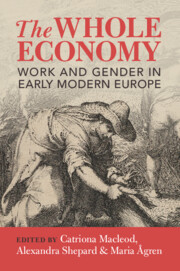6 - Migration
Published online by Cambridge University Press: 09 June 2023
Summary
Early modern Europe was a mobile society, but migration has primarily been described in terms of men seeking work, as labourers, apprentices, journeymen, soldiers or sailors. Long-distance migration was primarily male, but the much more common shorter-distance migration from countryside to town or from town to town was predominantly female. Men came to cities and often left again; women moved to cities and stayed. In most cities in Western Europe by 1700 women outnumbered men. This imbalance most likely resulted from women immigrating or men emigrating. Women, like men, moved primarily at younger ages and overwhelmingly in search of work. Women moving to towns are commonly associated with domestic service, but we show that only around half of all female immigrants worked as servants, and even these worked mostly for artisanal and trading households, assisting in the household business. The other half worked in institutions such as hospitals, as labourers in transport and as apprentices and journeywomen in manufacturing and the rapidly growing retail opportunities. We survey existing findings on female migration and the economic significance of marriage and lay out the territory for future research, challenging current theories on migration and showing the impact of gender.
- Type
- Chapter
- Information
- The Whole EconomyWork and Gender in Early Modern Europe, pp. 164 - 199Publisher: Cambridge University PressPrint publication year: 2023



